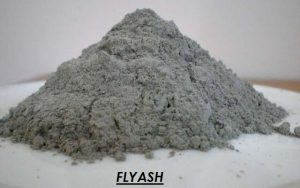
Value in Waste: Fly Ash Utilization and Money Making Opportunities
Fly ash (flue ash), also termed as pulverised fuel ash is a combusted product of coal. It comprises fine particulates of burned fuel extracted from the coal-fired broilers along with the flue gases. Ash that settles to the bottom removed from the broiler is called as the bottom ash. Based on the source and formulation of the coal being burned, the fly ash components differ considerably. However, all fly-ash products contain good quantities of Silicon dioxide (SiO2), Calcium Oxide (CaO), and Aluminium Oxide (Al2O3). These are the primary components of the rock stratum consisting of coal. The Fly ash can be classified into two types: Class F and Class C. Class F is extracted from bituminous and anthracite coals. It comprises majorly of alumina, silica, and has less calcium content in relative to Class C. While, Class C contains more than 20 percent of CaO and is termed as high calcium fly ash.
Related Projects: – Fly ash based value added products, Coal Ash utilization, Fly Ash as Raw Material, Products from Waste Project Reports
It can be used as an affordable replacement for Portland cement in several markets. It is an environmentally compatible compound, as it is a by-product and has low embodied energy. Contrastingly, Portland cement has more embodied energy as its manufacturing requires an immense amount of heat. Also, it requires less water and is convenient to use in cold weather. And the other advantages of fly ash are:
- Generates different set times
- Effective resistance to cold weather
- Higher-strength gains based on usage
- Can be used as an admixture
- It is a non-shrink material
- Generates dense concrete with a smoother finish and sharp detailing
- Good workability
- Minimises cracking, permeability issues, and bleeding
- Minimises hydration heat
- Enables for a lower water-cement proportion compared to no-fly ash mixes
- Minimises Carbon dioxide emissions
Thus, fly ash can be used as an affordable replacement for Portland cement in several markets. It is an environmentally compatible compound as it is a by-product and has low embodied energy. Contrastingly, Portland cement has high energy, as its manufacturing requires an immense amount of heat. The primary applications of fly ash are the production of Portland cement, bricks, soil stabilizing material, an ingredient in geopolymers, and roller compacted concrete dams. The construction sector is growing at a significant rate creating demand for raw materials like concrete, cement, iron, bricks, steel, and others.
Related Projects: – Fly ash based value added products, Coal Ash utilization, Fly Ash as Raw Material, Products from Waste
The expert NPCS team with a well-composed plan assures higher returns. We offer all the necessary information as per the project requisite.
Fly Ash Global Market Trends
The fly ash market is estimated to grow at a compounded annual growth rate (CAGR) of 6.2 percent from 4.43 US billion dollars in the year 2019 to 7.22 US billion dollars in the year 2027. The key market drivers of fly ash are the growing construction sector, infrastructure, road development, rules for handling fly ash, and rising focus on the use of environmentally compatible products. As illustrated below, class F Fly ash type exhibits market monopoly and is estimated to grow at a compounded annual growth rate of 6.7 percent. The reason being sulphate resistance, cost-effectiveness, and high functionality.
Related Books: – BOOKS & DATABASES
As demonstrated below, the end-use fly ash market (concrete and cement sector) is estimated to grow and account for 2.41 US billion dollars by the year 2027 due to the rising construction of dams, roads, bridges, and buildings across the globe. The bricks and blocks sector accounts for the highest CAGR of 7.2 percent during the estimated tenure, due to an increase in construction of commercial and residential sectors.
Geographically, Asia Pacific contributed to a maximum CAGR of 4.1 % due to the rising population in major emerging economies like India and China. India has road connectivity of 5, 903, 793 kilometres, and is the second-largest road network across the globe. While the North American market contributed about 24.5 percent of the market share in the year 2019 and would be growing significantly by the year 2027. Europe had a share of 21.2 % in the market in the year 2019. It is foreseen to grow at a CAGR of 6.6 % by 2027. The leading flyash brands in the market are Boral Limited, Lafarge North America Inc, Charah Inc, Flyash Direct, Sephaku Cement Limited, Aggregate Industries, Salt River Materials Group, Tarmac Holdings Limited, and Titan America LLC.
Fly Ash Indian Market Trends
The Asia Pacific holds a leading position in the global fly ash market. Additionally, initiatives by the Government of India initiatives such as NCAP (National Clean Air Programme) suggests usage of fly ash by 10 times to assure cleaner air and limit the damaging effect on the environment that facilitates market growth. Thus, the increasing government support and customer awareness about the products for construction usage is estimated to enhance the market demands for fly ash in the Asia Pacific region. Countries such as Indonesia, India, and China are the major producers of fly ash. Almost, 76 % of the total power in India is produced by power plants run on coal. The annual consumption of coal in India is 625 million tonnes. As per forecasts, the fly ash generation in the country would climb to 300 million tonnes by the year 2027. Thus, India is one of the potential fly ash markets to invest in and can offer viable business opportunities.
Related Videos: – Fly ash based Value Added Products, Coal Ash utilization
NPCS is one of the established brands in the industrial sector providing technical consulting. Having researched the market for ‘Fly ash’, production of the same would mean value-adding business investment.
Pr.Pet_Art20